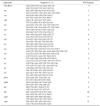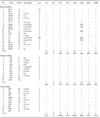1. Akineden Ö, Annemüller C, Hassan AA, Lämmler C, Wolter W, Zschöck M. Toxin genes and other characteristics of
Staphylococcus aureus isolates from milk of cows with mastitis. Clin Diagn Lab Immunol. 2001. 8:959–964.

2. Annemüller C, Lämmler C, Zschöck M. Genotyping of Staphylococcus aureus isolated from bovine mastitis. Vet Microbiol. 1999. 69:217–224.
3. Baba T, Takeuchi F, Kuroda M, Yuzawa H, Aoki K, Oguchi A, Nagai Y, Iwama N, Asano K, Naimi T, Kuroda H, Cui L, Yamamoto K, Hiramatsu K. Genome and virulence determinants of high virulence community-acquired MRSA. Lancet. 2002. 359:1819–1827.

4. Boerema JA, Clemens R, Brightwell G. Evaluation of molecular methods to determine enterotoxigenic status and molecular genotype of bovine, ovine, human and food isolates of
Staphylococcus aureus. Int J Food Microbiol. 2006. 107:192–201.

5. Booth MC, Pence LM, Mahasreshti P, Callegan MC, Gilmore MS. Clonal associations among
Staphylococcus aureus isolates from various sites of infection. Infect Immun. 2001. 69:345–352.

6. Brakstad OG, Aasbakk K, Maeland JA. Detection of
Staphylococcus aureus by polymerase chain reaction amplification of the
nuc gene. J Clin Microbiol. 1992. 30:1654–1660.

7. Brückler J, Schwarz S, Untermann F. Blobel H, Schlieβer T, editors. Staphylokokken-Infektionen und Enterotoxine band. II/I. Handbuch der bakteriellen Infektionen bei Tieren, 2. Auflage. 1994. Stuttgart: Gustav Fischer Verlag Jena.
8. Ferens WA, Davis WC, Hamilton MJ, Park YH, Deobald CF, Fox L, Bohach G. Activation of bovine lymphocyte subpopulations by Staphylococcal enterotoxin C. Infect Immun. 1998. 66:573–580.

9. Griffiths AJF, Wessler SR, Lewontin RC, Gelbart WM, Suzuki DT, Miller JH. An Introduction to Genetic Analysis. 2004. 8th ed. New York: Freeman WH;782.
10. Hayakawa Y, Hayashi M, Shimano T, Komae H, Takeuchi K, Endau M, Igarashi H, Hashimoto N, Takeuchi S. Production of exfoliative toxin A by
Staphylococcus aureus isolated from mastitic cow's milk and farm bulk milk. J Vet Med Sci. 1998. 60:1281–1283.

11. Hookey JV, Richardson JF, Cookson BD. Molecular typing of
Staphylococcus aureus based on PCR restriction fragment length polymorphism and DNA sequence analysis of the coagulase gene. J Clin Microbiol. 1998. 36:1083–1089.

12. Jarraud S, Cozon G, Vandenesch F, Bes M, Etienne J, Lina G. Involvement of enterotoxins G and I in staphylococcal toxic shock syndrome and staphylococcal scarlet fever. J Clin Microbiol. 1999. 37:2446–2449.

13. Johnson WM, Tyler SD, Ewan EP, Ashton FE, Pollard DR, Rozee KR. Detection of genes for enterotoxins, exfoliative toxins, and toxic shock syndrome toxin 1 in
Staphylococcus aureus by the polymerase chain reaction. J Clin Microbiol. 1991. 29:426–430.

14. Jönsson K, Signäs C, Müller HP, Lindberg M. Two different genes encode fibronectin binding proteins in
Staphylococcus aureus. The complete nucleotide sequence and characterization of the second gene. Eur J Biochem. 1991. 202:1041–1048.

15. Kuroda M, Ohta T, Uchiyama I, Baba T, Yuzawa H, Kobayashi I, Cui L, Oguchi A, Aoki K, Nagai Y, Kian J, Ito T, Kanamori M, Matsumaru H, Maruyama A, Murakami H, Hosoyama A, Mizutani-Ui Y, Takahashi NK, Sawano T, Inoue R, Kaito C, Sekimizu K, Hirakawa H, Kuhara S, Goto S, Yabuzaki J, Kanehisa M, Yamashita A, Oshima K, Furuya K, Yoshino C, Shiba T, Hattori M, Ogasawara N, Hayashi H, Hiramatsu K. Whole genome sequencing of meticillin-resistant Staphylococcus aureus. Lancet. 2001. 357:1225–1240.
16. Monday SR, Bohach GA. Use of multiplex PCR to detect classical and newly described pyrogenic toxin genes in staphylococcal isolates. J Clin Microbiol. 1999. 37:3411–3414.

17. Moore PCL, Lindsay JA. Genetic variation among hospital isolates of methicillin-sensitive
Staphylococcus aureus: evidence for horizontal transfer of virulence genes. J Clin Microbiol. 2001. 39:2760–2767.

18. Nilsson H, Björk P, Dohlsten M, Antonsson P. Staphylococcal enterotoxin H displays unique MHC class II-binding properties. J Immunol. 1999. 163:6686–6693.
19. Nishi J, Yoshinaga M, Miyanohara H, Kawahara M, Kawabata M, Motoya T, Owaki T, Oiso S, Kawakami M, Kamewari S, Koyama Y, Wakimoto N, Tokuda K, Manago K, Maruyama I. An epidemiologic survey of methicillin-resistant
Staphylococcus aureus by combined use of mec-HVR genotyping and toxin genotyping in a university hospital in Japan. Infect Control Hosp Epidemiol. 2002. 23:506–510.

20. Sandel MK, McKillip JL. Virulence and recovery of
Staphylococcus aureus relevant to the food industry using improvements on traditional approaches. Food Control. 2004. 15:5–10.

21. Sheagren JN. Staphylococcus aureus: the persistent pathogen. N Engl J Med. 1984. 310:1368–1373.
22. Soell M, Diab M, Haan-Archipoff G, Beretz A, Herbelin C, Poutrel B, Klein JP. Capsular polysaccharide types 5 and 8 of
Staphylococcus aureus bind specifically to human epithelial (KB) cells, endothelial cells, and monocytes and induce release of cytokines. Infect Immun. 1995. 63:1380–1386.

23. Stephan R, Annemüller C, Hassan AA, Lämmler C. Characterization of enterotoxigenic
Staphylococcus aureus strains isolated from bovine mastitis in north-east Switzerland. Vet Microbiol. 2001. 78:373–382.

24. Stewart CM. Hocking AD, editor. Staphylococcus aureus and Staphylococcal Enterotoxins. Foodborne Microorganisms of Public Health Importance. 2003. 6th ed. Sydney: The Food Microbiology Group of the Australian Institute of Food Science and Technology Inc.;359–379.
25. Straub JA, Hertel C, Hammes WP. A 23S rDNA-targeted polymerase chain reaction-based system for detection of
Staphylococcus aureus in meat starter cultures and dairy products. J Food Prot. 1999. 62:1150–1156.

26. Tsen HY, Chen TR. Use of the polymerase chain reaction for specific detection of type A, D and E enterotoxigenic Staphylococcus aureus in foods. Appl Microbiol Biotechnol. 1992. 37:685–690.
27. Zhang S, Iandolo JJ, Stewart GC. The enterotoxin D plasmid of
Staphylococcus aureus encodes a second enterotoxin determinant (
sej). FEMS Microbiol Lett. 1998. 168:227–233.








 PDF
PDF ePub
ePub Citation
Citation Print
Print




 XML Download
XML Download